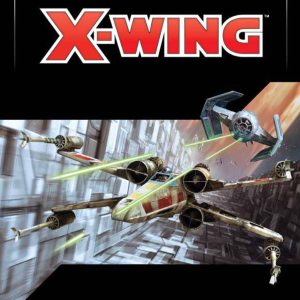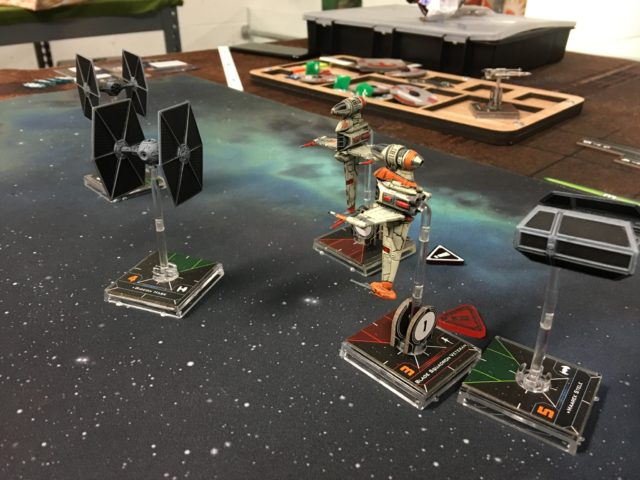
The snappily titled “X-Wing The Miniatures Game” was launched by Fantasy Flight Games (FFG) in 2012, and immediately caught the attention of the tabletop gaming market. A combination of the Star Wars juggernaut with FFG’s beautifully detailed and pre-painted ship models made the game instantly popular. Subsequently waves of expansions introducing additional factions, upgrades, modifications, pilots, factions, ship types, rulesets… until fast forward to late 2017 with wave XIII of ships being released X-Wing was starting to creak under its own weight.
Then in May this year, FFG made the surprise announcement that they were launching a “2nd edition” of X-Wing, with the rules streamlined, refocused, and restructured, with the capacity and flexibility to take on years worth of expansions and additions FFG had planned. Not only that, they released conversion packs, so owners of first edition ships did not have to re-purchase them all.
As a recent discoverer of the tabletop scene, I felt that the sheer size and breadth of X-Wing made it unapproachable – but with this combined reboot and relaunch, it felt like the perfect opportunity to see what all the fuss was about.
So let’s rewind somewhat. What actually IS X-Wing? As the original first edition’s title suggests, it is a miniatures game, essentially with you and an opponent performing elaborate dogfights in the Star Wars universe, preselecting your ship’s manoeuvres, then letting them play it out, to devastating, horrific, or even comedic effect.
However you’re not just choosing the ships, but you are choosing pilots and upgrades too. All of these have a points value, so you and your opponent both build your squad to an agreed value (to keep things balanced), and your selections determine what options are available to you, what types of manoeuvres your ship and pilot can make, and how much damage you can deal.
Having said that, this new edition of the game only comes with three ships – two TIE fighters and one X-Wing, so the choices available to you from the outset are pretty limited.
FFG have anticipated this, and have introduced two additional ways to play the game that were not present in the original, to help you get move value for money out of it.

Firstly, instead of laboriously calculating the points values of your squad, the game comes with a set of “Quick Build” cards that include sets of pilots and upgrades for each ship with a “threat level” rating. So you can simply pick two level 2 TIE fighters against one level 4 X-Wing and be confident that you have an evenly matched game without all the faff.
Once you have familiarised yourselves with the rules, and played around with threat levels a bit, you may find yourself wanting more, which is where the second game mode comes in: “Escalation”. Recognising the limitations of only having the three ships of the starter set, Escalation lets you simulate a larger scale battle without the expense of buying more ships. The game starts off using lower threat level squads, but as your ships get eliminated, you bring them back in with a different pilot at a higher threat level, replicating backup arriving at the opportune moment. It is a brilliant way of getting more out of the core set.
One of the biggest dead ends that the original X-Wing was forced into, was how to deal with ships that turned out to be relatively overpowered as the game evolved. As the points values were printed on the game components, it restricted what they could do. So the biggest change in the second edition is the removal of all pre-printed points costs. Instead, you use the official app or website, or download the current PDF, to build your squad. This gives FFG the facility to tweak the values on the fly as the game evolves.
Some people begrudge technology encroaching into their tabletop hobby, but FFG have handled it well. OK it may be a little clunky having to refer back from game components to whichever points source you choose to use as you build your squad, but I think that’s a small price to play to ensure the game’s longevity. On the plus side, you can build your squad on your lunch break with nothing more than your phone!
So how does it play? I’ve played a number of games, both at home with my son, and in our local games store where they run regular X-Wing nights, and I thoroughly enjoyed it. There are strategic choices to be made, as you and your opponent preselect your ship manoeuvres, trying to anticipate each other’s moves. One moment you can pull the equivalent of a perfect handbrake turn, dropping right behind that pesky TIE fighter that’s been after you for ages. The next you miscalculate an evasion and crash into the dark lord of the Sith himself. Or accidentally select “right” when you meant “left” resulting in your ship careering off the edge of the battlefield into deep space.
There is a lot to learn, not just about your ships, but understanding your opponent’s capabilities. It’s also not a cheap hobby, there is an almost unlimited number of ships to spend your money on. But if you are willing to invest in it, you will find some of the most fast-paced and satisfying tabletop dogfighting around.

Leave a Reply